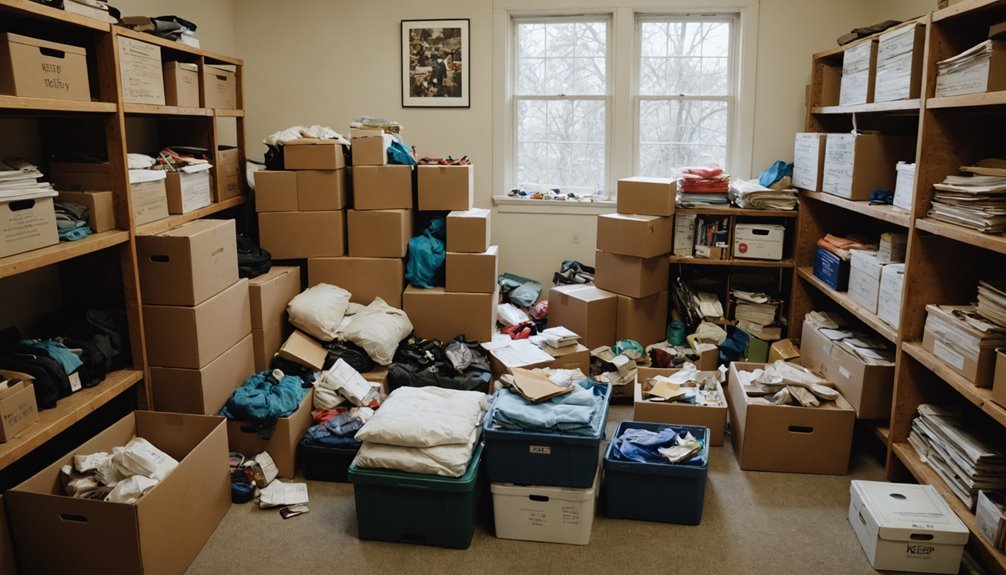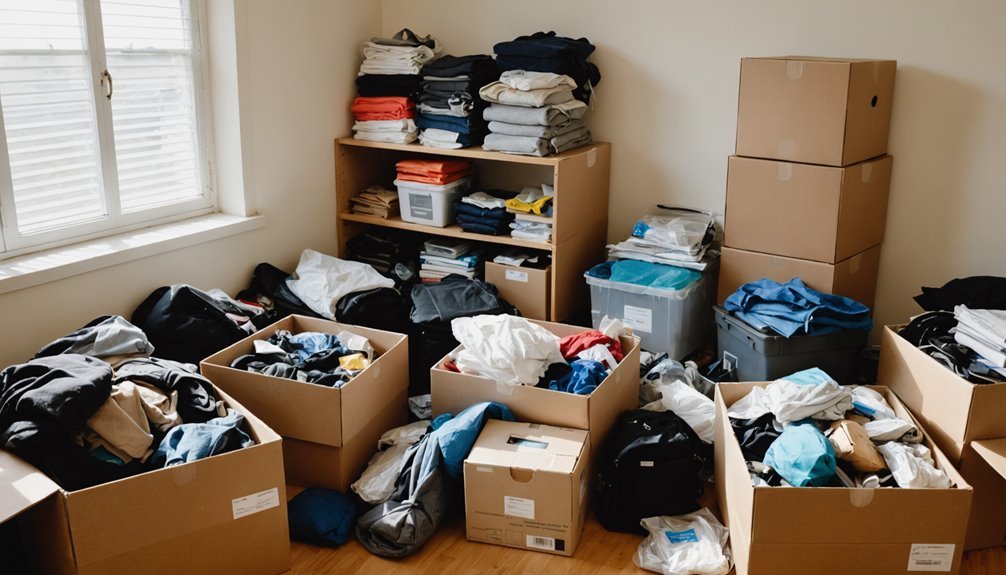As you prepare for your upcoming move, you're likely facing the intimidating task of deciding what to keep, donate, or toss. It's important to approach this process methodically, considering both the practicality and sentimental value of your belongings. Start by sorting items into categories, and ask yourself if each item will serve a purpose in your new home. This method not only simplifies your move but also reduces unnecessary baggage. However, the real challenge lies in making these tough decisions—what criteria should you use, and how do you handle the emotional aspect of parting with personal items? Let's explore some effective strategies to help you make informed choices.
Key Takeaways
- Assess each item's practicality, emotional value, and condition to decide whether to keep, donate, or toss.
- Utilize the Keep, Donate, Sell, Toss method to categorize items efficiently during the decluttering process.
- Sell valuable but unnecessary items on platforms like Craigslist or eBay, or through a garage sale.
- Donate items in good condition to local charities for a potential tax deduction and to support the community.
- Dispose of damaged or hazardous materials responsibly, adhering to local disposal regulations.
Understanding Decluttering Benefits
Understanding the benefits of decluttering before you move can considerably cut your expenses. When you sift through old items, deciding what to donate or toss, you're not just clearing space but also tailoring your moving process to be more efficient and less costly.
By eliminating unnecessary belongings, you'll need fewer packing supplies, saving money on boxes, bubble wrap, and tape. This selective approach leads to a more organized packing experience, ensuring everything has its place, which simplifies unpacking in your new home. Additionally, reducing clutter allows you to prioritize essential items, making the moving process more efficient and stress-free. Implementing packing tips from professional movers, such as labeling boxes by room and using soft items like clothing to cushion fragile items, can further streamline the experience. These expert strategies not only save time but also help protect your belongings during the move.
A streamlined moving experience isn't just about organization; it's about reducing the physical and mental stress often associated with moving. Fewer items to worry about means less to pack, move, and unpack, which accelerates the entire process and lets you settle into your new space faster.
Additionally, decluttering offers a chance to transform old items into extra cash. Selling things you no longer need can supplement your moving budget, easing financial pressures and possibly covering the cost of professional movers or high-quality packing materials.
Embrace decluttering as a strategic step in your moving journey. It's not just about getting rid of things—it's about paving the way for a smoother, more cost-effective move.
Deciding What to Keep
When you're ready to declutter before a move, deciding what to keep can seem intimidating. It's crucial to sift through your belongings methodically, focusing on the practical and emotional values each item holds.
Here's how you can effectively tackle this part of your decluttering process:
- Assess Practicality: Does the item serve a purpose in your new home? If it hasn't been used in the past year or doesn't fit the layout and design of your new space, it's probably time to reflect on if it should be on your moving checklist to keep, donate, or toss.
- Emotional Value: Keep items that genuinely bring you joy or hold a deep sentimental value. If something tugs at your heartstrings and you can't imagine your new space without it, it's a keeper.
- Condition Check: Discard items in poor condition. Moving with damaged goods can clutter your new beginning.
- Space Compatibility: Reflect on the dimensions and aesthetics of your new home. Will your current furniture and decor harmonize with the new environment?
- Simplify Your Choices: Use the Keep, Donate, Sell, Toss method as a guideline to streamline your decisions and keep only those items that are truly essential or cherished.
Handling the Discard Pile

Once you've decided what items won't be making the move with you, it's time to handle the discard pile effectively.
Start by categorizing your items into "Sell," "Donate," and "Toss." This simple step, often recommended by Professional Organizers, streamlines your decluttering process and helps in getting rid of clutter more efficiently.
For items in good condition but no longer needed, consider selling them. Platforms like Craigslist or eBay are great for this, and you might even recoup some moving costs.
Hosting a garage sale is another fantastic option, especially for selling old clothes and other household items quickly while engaging with your community.
If you're looking to donate, usable items that don't fit your lifestyle anymore can be given to local charities like Goodwill or Habitat for Humanity ReStore. This not only clears your space but also provides you with possible tax deductions.
Lastly, it's essential to responsibly toss broken items and expired food.
Make sure that hazardous materials, such as old electronics or chemicals, are disposed of according to local regulations. This step guarantees you leave no trace of clutter behind as you move on to your new home.
Efficient Decluttering Strategies
After handling your discard pile, you'll want to adopt efficient decluttering strategies to further streamline your moving process.
By focusing on what to Keep, Donate, Sell, or Toss, you can notably declutter your home, guaranteeing a smoother shift on moving day.
Here are some essential tips for decluttering effectively:
- Evaluate Items Systematically: Start by evaluating items in one room at a time. Check their condition, frequency of use, and emotional value to decide whether they'll make it to your new home or not.
- Create a Personalized Decluttering Checklist: This checklist will make certain you don't overlook any items or areas. List out all rooms and item types for a thorough approach.
- Use the Keep, Donate, Sell, Toss Method: Categorize each item based on its value and usability. This simplifies decision-making and helps manage your storage space efficiently.
- Rent a Storage Space: For items you can't part with but won't need immediately, consider renting a storage unit. This keeps your new space uncluttered while you settle in.
- Focus on One Area at a Time: Avoid the overwhelm by tackling small sections daily. This keeps the momentum going without burning you out.
Expert Insights and Advice

While it's crucial to adopt a systematic approach to decluttering, expert organizers highlight the importance of starting early. They recommend kicking off the process a few months before your move. This gives you ample time to purge without feeling rushed.
One useful strategy they suggest is the "Keep, Donate, Sell, Toss" method, which helps you systematically decide what stays and what goes based on necessity and emotional value.
Consider donating items you haven't used in the past year. This one-year rule is a favorite among expert organizers because it targets those rarely used items that clutter your space. Meanwhile, selling items online can be both financially rewarding and a way to responsibly declutter.
To guarantee nothing is overlooked, experts advise creating personalized checklists for each room in your home. These lists guide you through a thorough review of your belongings, making sure you consider each item's future utility and emotional worth.
Community Engagement and Stories
Engaging with your community during the decluttering process not only lightens your load but also deepens local connections.
When you share your journey of sorting and letting go, you tap into a supportive network that offers both emotional support and practical advice. This shared experience can foster a stronger sense of belonging and collective responsibility.
Consider these avenues to enhance your community engagement:
- Host a Neighborhood Garage Sale: Invite your neighbors to declutter together and organize a community garage sale. It's a fun way to connect and help each other out.
- Utilize Social Media: Share your decluttering progress on platforms like Instagram or Facebook using hashtags like #dumpstersblog to connect with others on a similar path.
- Donate to Local Charities: Give your gently used items a new home and support local charities. It's a meaningful way to contribute to your community.
- Share Tips and Stories: Exchange stories and tips with your neighbors or online communities about the best ways to tackle clutter.
- Build a Supportive Network: Engage in conversations that build a network of friends who offer support and celebrate your decluttering successes.
Frequently Asked Questions
Is It Better to Donate or Sell When Decluttering?
Deciding whether to donate or sell during decluttering depends on several factors.
If you're looking for quick financial gain, selling strategies on platforms like eBay can be effective, especially for high-value items.
However, donation benefits, like tax deductions and community impact, are significant.
Consider your attachment to items and the time you have—donating can be quicker and more eco-friendly, helping reduce stress and promote a positive decluttering mindset.
How Do You Decide What to Keep or Toss When Decluttering?
When deciding what to keep or toss, consider each item's practical use, condition, and how often you use it.
Assess whether it's worth the space it takes up or if you'd buy it again, factoring in future relevance and potential lifestyle changes.
Emotional attachments and sentimental value are important, but weigh them against a decluttering mindset focused on minimizing and optimizing space.
This balance will guide your decisions effectively.
How to Decide What to Throw Away When Moving?
When deciding what to throw away while moving, consider each item's practical usage, emotional attachment, and sentimental value.
Assess how often you've used it recently and its condition. Think about space limitations in your new place and future needs.
Weigh the cost of moving it against its replacement ease. Don't forget the time investment in packing and unpacking items.
This method helps prioritize what truly matters for your next chapter.
What Is the Rule of 5 Decluttering?
The Rule of 5 is a decluttering strategy that helps you manage decision fatigue and optimize space by tossing out five items daily.
It's perfect for fostering a minimalist mindset, reducing emotional attachment, and simplifying possessions.
You'll find the rule benefits your time management and enhances organizational skills.
As you prepare your moving checklist, this approach gradually declutters your space, making the process manageable and aligning with essential organizational tips for a smoother change.
Conclusion
Now that you're equipped with strategies and insights on decluttering before moving, it's time to get started. Remember, each item you decide to keep, donate, or toss simplifies your move and your life. Engage with your community for support and share your stories to inspire others. You'll not only lighten your load but also pave the way for a fresh start in your new home. Immerse yourself and enjoy the journey to a clutter-free space!


